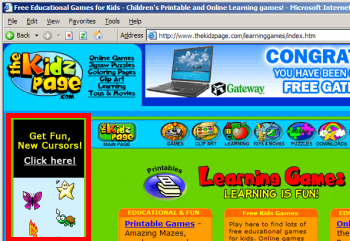 Ask toolbar ads running on TheKidzPage.com, a site catering to kids.
Ask toolbar ads running on TheKidzPage.com, a site catering to kids.



Ask ad elements that cater to kids via cartoons, smiling faces, etc.
|
Current Practices of IAC/Ask Toolbars I present and critique current installation and operation practices of certain toolbars provided by InterActiveCorp/Ask. |
Related Projects 180solutions & Affiliate Commissions WhenU Violates Own Privacy Policy |
As the fifth-biggest search engine, Ask faces a clear problem: How to get users to leave their favored search engines, to conduct their searches at Ask instead? One Ask strategy is to buys ads on TV and in other media, claiming to offer a better product. But Ask also drives traffic to its search engine by enticing users to install its toolbars. This article looks at Ask's current and recent toolbar practices, including:
Throughout, I compare these practices to the statements of Ask's staff, and I compare these practices with applicable legal and ethical duties.
I use the term "Ask toolbars" to refer to the IAC products at issue. Details on why I chose this name.
Advertising on Kids Sites; the Significance of Targeting Kids
 Ask toolbar ads running on TheKidzPage.com, a site catering to kids.
Ask toolbar ads running on TheKidzPage.com, a site catering to kids.



In May 2005, I documented Ask toolbars soliciting installations on kids sites. An Ask staff person subsequently wrote to me, claiming: "within Ask Jeeves, there is no targeting of kids going on." (Personal email, on file, September 2005.)
Despite Ask's claims, I remain confident that Ask ads "target kids" in the sense of appearing on web sites that primarily serve children. See e.g. the top image at right, showing an Ask ad appearing on TheKidzPage.com, a site that -- by its very name -- readily admits that it primarily caters to kids.
The nature of Ask's ads also confirms that Ask targets kids. See the ad design elements shown below and at right -- all incorporating overstated smiling faces, cartoon characters, and other design elements that disproportionately attract young users. Furthermore, when Ask's ads include audio, they generally feature exclamations in typical youth language (e.g. oh my god! and no way!). The net effect of these design characteristics is that, even when Ask's ads are shown on sites catering equally to adults and to kids, Ask's ads are particularly likely to catch the attention of kids.
FTC authority confirms the significance of including cartoon-style design elements. The FTC's COPPA FAQ, specifically cites "use[] of animated characters" as an appropriate factor to consider when determining whether materials are "targeted to children." Furthermore, FRC Rule 16 CFR Part 312 provision 312.2, defines sites "directed to children," calling for an examination of subject matter, visual and audio content, age of models, and, specifically, the use of animated characters.
What's the big deal about targeting kids? Kids are less likely to read, understand, and appropriately evaluate the offer Ask seeks that they accept. Indeed, Ask's own license agreement specifies that Ask's toolbars must not be installed by users under age 13, or by users under 18 unless they obtain parental consent. But despite Ask's license agreement language to the contrary, Ask's advertising practices make it inevitable that Ask's toolbars in fact will be installed by users below those ages: By advertising on sites primarily or substantially serving users below those ages, and by designing ads that disproportionately target users below those ages, Ask invites kids to install its software.
As a matter of law, targeting kids imposes some special duties. For example, the Children's Online Privacy Protection Act (COPPA) establishes special duties as to collecting certain personal information from children. But Ask's toolbars do not generally focus on collecting such information (although users often use toolbars to conduct sensitive, identity-revealing searches that include such information). So COPPA seems unlikely to impose substantial requirements on Ask.
Most states' contract doctrines allow unilateral revocation when a minor enters into a contract. That is, the minor (or the minor's guardian) may revoke the contract and escape whatever duties the contract required of the minor. But revocation makes no sense in the context of Ask's toolbars. Computer users always have the option of removing Ask's toolbar, so Ask complies with the requirement of allowing revocation (as to children and as to everyone else). Yet when a child installs Ask software, damage occurs immediately: The toolbar becomes present on the user's PC, unwanted by the primary user or owner of the PC and perhaps also unwanted by the minor.
Ordinarily, the legal principal of revocation serves to protect children from unwanted commercial relationships. Because a parent can cancel a child's duties under any supposed contract, businesses are deterred from attempting to contract with children in the first place. But here, Ask is always willing to let children (and everyone else) remove Ask's toolbars at will. So the legal principle of revocation does not serve to protect PC owners or to deter Ask from soliciting children for toolbar installations.
On one view, Ask's targeting of children presents no policy concern: Yes, Ask targets kids, but it (arguably) does what the law requires in its dealings with children, so some might conclude there's nothing wrong here. But my view is that Ask's behavior is noteworthy. Ask's representative vehemently denied that Ask targets kids, and for good reason: It would be unseemly, at best, to build a business by convincing kids to install software they don't need and are ill-equipped to understand. Yet that's my best assessment of Ask's toolbar installation practices.
to topAdvertising that Appears to Be Part of Others' Sites
In my companion piece The Ad / Content Separation, and Ask.com Advertising at MySpace, I analyze Ask.com ads shown at MySpace. The format and design of these ads creates a special risk of confusing users about the origin and effect of the software offered. I identify the specific factors likely to cause such confusion, and I suggest possible improvements.
to topAdvertising through Other Vendors' Spyware
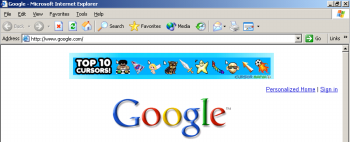 FullContext injects an Ask ad into Google, without Google's permission
FullContext injects an Ask ad into Google, without Google's permission
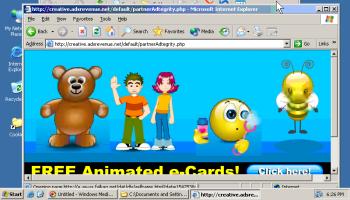
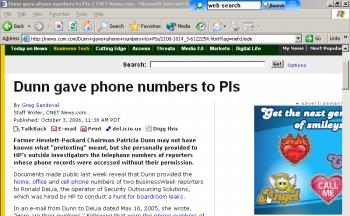
I have repeatedly observed Ask toolbars promoted through other vendors' spyware. Such advertising has two key effects: First, it helps fund the spyware ecosystem, with money flowing from Ask to various spyware vendors, ultimately fueling more infections of users' computers. Second, it puts Ask ads in front of even more users -- including in prominent ad placements Ask could not obtain in any other way.
See e.g. the first screenshot at right. Notice the Ask "Top 10 Cursors" ad at page top-center, a place where Google does not sell ads to any company at any price. FullContext accomplishes this injection using its spyware, which is widely installed onto users' PCs without their consent. I received this ad on August 29, 2006.
See also the second screenshot at right. Spyware from SearchingBooth opened a barrage of popups. I closed all but one, leaving this large Ask ad. SearchingBooth spyware is widely installed without users' consent. I received this ad on October 2, 2006.
See also the third screenshot at right. Spyware from DollarRevenue replaced the ad originally shown by c|net News.com, instead showing this Ask "smiley" ad instead. That is, the Ask ad completely and exactly covered the ad c|net had intended to place into this page. I have on file a packet log and video sufficient to prove that this placement was performed by DollarRevenue spyware, not by c|net. The net effect is that c|net and its advertiser get no revenue benefit from the editorial content c|net staff created. In contrast, DollarRevenue and Ask grab users' attention without having to create editorial content of their own. I received this ad on October 3, 2006.
I was recently forwarded a September 2006 email from an Ask representative, specifically discussing Ask.com's advertising practices. The Ask representative claimed that Ask has cleaned up the advertising networks that we use [for promoting toolbars]. This claim stands in stark contrast to Ask's ongoing use of spyware, as shown above and at right. I see no way to reconcile the Ask representative's claim with he advertising placements I have observed. In short, I think the Ask representative was mistaken in claiming that Ask has "cleaned up" its advertising practices.
Each of these ads was placed through intermediaries. But as an advertising powerhouse, Ask is ill-equipped to argue that buying online advertising is too complicated for Ask to do a good job. In any event, Ask's representative specifically claimed that Ask has "cleaned up the advertising networks" it uses -- not that it has tried to make improvements, or that it hopes to improve, but that it purports to have actually and already done so.
to topOngoing Nonconsensual Installations of Ask Toolbars
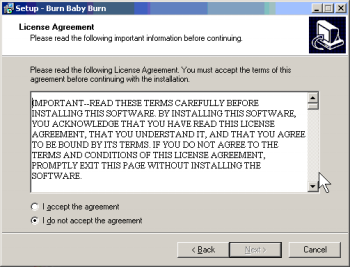 The Burn Baby Burn installer makes no mention of Ask software
The Burn Baby Burn installer makes no mention of Ask software
 Burn Baby Burn installs an Ask toolbar without permission
Burn Baby Burn installs an Ask toolbar without permission Last year I documented nonconsensual exploit installs of Ask's toolbar using browser exploits (one of several examples in my files). I have not seen other exploit-based nonconsensual installations of Ask toolbars this year. But I've still seen undisclosed nonconsensual installations of Ask software -- where a user requests one program, and entirely undisclosed receives Ask's toolbar too.
See e.g. this video (made October 15, 2006), showing my download and installation of a program called "Burn Baby Burn." I scroll through the entire EULA (also preserved in text form), confirming no mention of any bundled Ask toolbar or any other bundled software. See first screenshot at right. But when I then open my browser, an Ask toolbar appears. See second screenshot at right. That installation was non-consensual -- I didn't agree to receive any Ask toolbar. Yet it appeared anyway.
This example was remarkably easy to find; I found it in less than half an hour of hands-on testing, using my (confidential, proprietary) methods. And this is but one of several nonconsensual Ask installations previously documented. Recall my prior proof of exploit installations, with additional examples on file. See also Sunbelt Software's September 2005 report documenting an Ask partner that installs Ask's software even if users specifically cancel installation.
These many nonconsensual installations of Ask's software reflect a deeper problem with Ask's practices: Ask has many -- hundreds? thousands? -- of toolbar distribution partners, and no effective way to monitor or supervise them. Ask would be better off with fewer, more trustworthy distributors. But of course such a strategy brings its own challenges: Trustworthy companies might not want to distribute Ask's toolbar, might charge higher fees for doing so, or might find they cannot effectively do so if they (unlike these Ask partners) actually seek user consent before installing Ask software on users' PCs.
My advise for Ask: Abandon the installation of toolbars through partners. It's hard to supervise so many partners, and Ask has repeatedly demonstrated its inability to supervise partners effectively.
to topAsk's Current Typical Installation Sequence, vis-a-vis Applicable Promises and Legal Requirements
I credit Ask for making some improvements in its standard installation sequence. Last year, Ask never mentioned the word "toolbar" to describe its product, even though that is the only single word that meaningfully describes what Ask offers. Now, that word is reasonably prominent in many of Ask's installation sequences.
Nonetheless, some elements of Ask's installation sequence continue to hinder users in their attempts to understand what Ask offers. For example, a multicolored background image makes much of Ask's text remarkably hard to read. Example. But the button that continues installation is large, prominent, brightly-colored, and opaque -- therefore well distinguished from the background. As a result, users are likely to have difficulty reading the details of Ask's offer, even as the button to accept the offer is easy to read -- a practice that encourages users to accept Ask's offer without first pausing to understand it.
Even where Ask has made specific commitments to improve its installation sequence, it has not always done so. For example, in September 2005, an Ask representative emailed me the following claim: That Ask's EULA link is "still on the 800x600 screen even with a couple of toolbars installed." (Personal email, on file.) For some Ask installations, that may be true. But it is easy to find others where that claim is false. See this example, the result of clicking the ad shown in the SearchingBooth spyware-delivered ad example (in the preceding section).
In my view, the core problem with Ask's installation sequence is that it uses deception to get users' attention initially. Ask baits users with one offer ("free smileys" or similar). But Ask ultimately offers a product that's quite different (free smileys plus an intrusive browser toolbar). I'm reminded of Federal Trade Commission v. Encyclopaedia Britannica, Inc., 87 F.T.C. 421 (1976), holding that Britannica salesmen deceived consumers via their "deceptive door opener" statements -- quick initial lines to cause consumers to let salesmen into their homes, at which point salesmen gave a full sales pitch for encyclopedia sets. This case holds that Britannica deceived consumers through its initial statements even though the truth (i.e. that the salesman was selling encyclopedias) was revealed prior to the consumer's purchase. (The key quote: "[T]he law is violated if the first contact ... is secured by deception, even though the true facts may be made known at a later date.") In some respects, Ask's practices are remarkably similar to Britannica's: Ask shows its "free smileys" (or similar) banner ads to entice users -- the electronic equivalent of getting through a user's front door. Then Ask later explains, in its landing pages, that it requires users to accept toolbars in order to get the smileys, just as Britannica apparently ultimately explained its offer. But here the deceptive door opener doctrine steps forward in full force: Having attracted consumers' attention by a misleading statement, Ask's subsequent admissions are inadequate to cure the initial deception.
The FTC Guide Concerning Use of the Word "Free" is also on point. The guide requires: "When making 'Free'' or similar offers all the terms, conditions and obligations upon which receipt and retention of the 'Free'' item are contingent should be set forth clearly and conspicuously at the outset of the offer so as to leave no reasonable probability that the terms of the offer might be misunderstood." Ask does not comply with this requirement either. Ask's ads promise "free smileys" and similar, and no contemporaneous statement admits the additional terms required to receive this "free" offer (namely, the mandatory acceptance of a toolbar). The FTC's guide specifically instructs that no subsequent statement can cure a company's failure to provide this disclosure at the outset of the offer. Ask's subsequent disclosures and license agreement are therefore irrelevant in assessing Ask's compliance with the FTC's outset-of-the-offer requirement.
Ask's Download Guidelines document sets out the company's view of appropriate download practices. One relevant paragraph:
"Misleading Downloads: this is a practice where a company misrepresents the nature of the program it seeks to download and install onto a user's computer by claiming that the program is necessary to the proper function of the user's system." (emphasis added)
Ask's first clause is accurate. But Ask errs in the italicized section, where Ask claims that there is only one way to misrepresent a download, namely (according to Ask) "by claiming that the program is necessary to the proper function of the user's system." In fact there are many ways to misrepresent a download. An example particularly relevant for Ask: A company misrepresents a download if it claims to offer "free smileys" (with nothing more), but actually requires users to accept a browser toolbar. More generally, a misleading download can be premised on any kind of deception, not just the specific single example Ask describes. A better definition of misleading downloads would, correctly, encompass Ask's misleading distribution practices.
Even Ask's EULA is cause for concern. At 7,866 words in length, it is among the longest EULAs I've ever looked at -- 25% longer than it was last year, 52% longer than the Windows XP EULA, 70% longer than the US Constitution, and a remarkable six times longer than the Google Toolbar EULA.
There's plenty more to criticize about Ask's installation procedures -- troubling substantive provisions in its EULA; installations bundled with all manner of dubious third-party software; Ask's own installations that bombard users with secondary popups if users change their mind about installing. But I'll save these behaviors for another day.
to topEffects When Installed: Browser Rearrangement, Excessive Sponsored Links
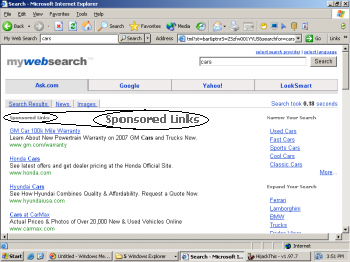 Ask's landing pages include unusually numerous and prominent ads
Ask's landing pages include unusually numerous and prominent ads
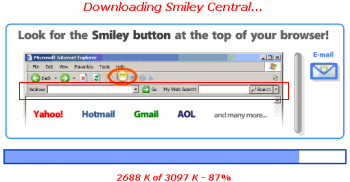 An Ask installation screen misrepresents effects on browser arrangement
An Ask installation screen misrepresents effects on browser arrangement The most prominent effect of installing Ask's toolbars is to rearrange key browser components. Consider the placement of the browser's Address Bar (the main location into which a user types a web address in order to navigate to a web page). In a standard installation of any typical web browser (including Internet Explorer, FireFox, Netscape, and even the original 1997 NCSA Mosaic 0.6), this box appears at the browser's top-left corner -- a natural location for such a crucial feature. But Ask moves the box to the top-right, making room for its own search box at top-left. The resulting arrangement is shown in the top screenshot at right.
As a result, when a user types a domain name into the top-left box, the user is taken to a list of Ask results, rather than to the domain the user requested. This behavior stands in sharp contrast to, e.g., the Google Toolbar -- which, when a user's "search" is actually a domain name, instead sends users directly to that domain. Furthermore, mainstream toolbars (Google, Yahoo, etc.) do not rearrange browsers' Address Bars as Ask's toolbars do.
Ask directly benefits from users' extra and unintended searches. Ask's toolbars take users to pages that feature unusually overwhelming sponsored links. See e.g. the second screenshot at right. I use Ask's toolbar to search for "cars." I am taken to a "MyWebSearch" page that begins with ten sponsored links, filling more than two full pages of my 800x600 screen. These sponsored links all appear above even the first organic link. In contrast, a leading search engine (like Google or Yahoo) would typically show at most three ads above organic results. The prominence of these sponsored links redounds to Ask's benefit: When users conduct a search through this Ask toolbar, users are highly likely to end up clicking on a sponsored link -- more so than on a typical search engine results page, where sponsored links are less prominent.
Several factors heighten the risk of user confusion from Ask's rearrangement of users' browsers. For one, the rearrangement is inconsistent with and unrelated to the feature users had specifically requested (e.g. "free smileys"). For another, Ask fills the Address Bar's standard location with a search box that looks much like an address bar: Both are text boxes with simple white backgrounds. Users who select that box instinctively, rather than carefully reading the box's language and realizing its changed purpose, are likely to conduct a search when they intend to perform a direct navigation.
Notably, some Ask installations make false statements about the browser rearrangement they will perform. See e.g. the bottom screenshot at right, observed during an Ask SmileyCentral installation on October 14, 2006. Notice the region within the red rectangle (added by me). Ask falsely shows the user's Address Bar as appearing at browser left, and the My Web Search box at right. In fact, the resulting ordering of these components will be exactly the opposite of what Ask shows.
Ask's toolbars have previously included various other noxious practices. For example, Ask toolbars previously added advertising footers to the bottom of users' outbound emails. However, my recent testing indicates that these features are not currently active.
to topAsk's Practices in Context
I stand by my prior unfavorable view of Ask's toolbars: Users may well want the trinkets Ask touts, like smileys and screensavers. But few users want the resulting toolbars (with their confusing rearrangement of browser windows) or search results (with excessive sponsored links). Hence Ask's decision to resort to bait-and-switch and misleading-door-opener tactics -- touting the desired features, only to add in the rest later. And hence Ask partners' repeated decisions to install Ask toolbars even if users don't agree.
When I find an Ask toolbar on a user's PC, it typically remains the case that that user doesn't know where it came from, doesn't want it, and happily accepts my offer to remove it. Until Ask ceases its pushy (and in some cases entirely nonconsensual) installation practices, and until Ask develops a product users actually want (not just in part, but in full), I expect that such removals will remain necessary.
Posted: October 16, 2006. Last Updated: October 21, 2006 - Sign up for notification of major updates and related work.